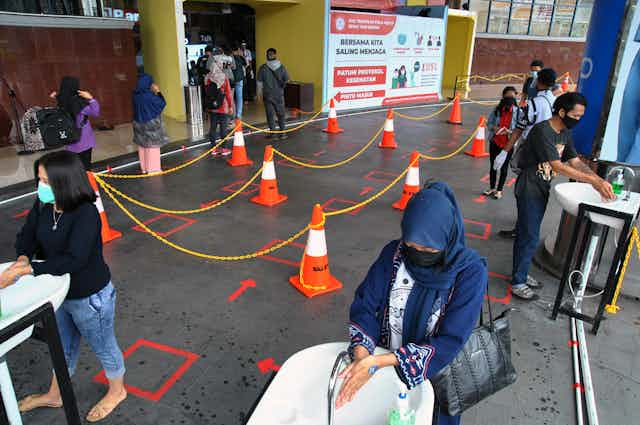The daily increase in the number of new COVID-19 cases in Indonesia is a long way from slowing down. But Indonesia will still go ahead with its decision to move to a “new normal” to revive its sinking economy. Under this policy, people can return to work and school while shops and malls start to open with health precautions.
Last week was tough for Indonesia, with new cases reaching a record of more than 1,000 seven days in a row. On Wednesday, Indonesia overtook Singapore as the country with the most COVID-19 cases in Southeast Asia.
Indonesia is under pressure to re-open its economy to stimulate growth, reduce unemployment and prevent a further escalation of poverty.
But Indonesia’s new normal directive suffers from three serious flaws. We propose three ways to promote a new normal directive in Indonesia that will be suitable to all Indonesians.
The curve isn’t in decline
President Joko Widodo announced the new normal protocol on May 15.
Since then, politicians and businessmen have been using the new normal narrative to navigate economic uncertainties brought by the COVID-19 pandemic. They argue a new normal might lead to social stability, and promote faster economic recovery and growth.
But talk of a new normal creates a false sense of security and encourages people to think Indonesia has the pandemic under control. Given the number of cases continues to rise, Jokowi’s directive is premature.
Indonesia’s pandemic curve shows no sign of decline, since April 2020. As of June 24, there are 49,009 cases with a fatality rate of 5.3%. In the last 24 hours, as many as 1,113 new cases have been recorded.
Testing rates remain among the lowest in the world. As of June 24, only 2,444 per one million people have been tested – compared to Singapore (116,996 per one million), Australia (84,459) and Malaysia (21,436).
The number of infections remains among the highest in the world too. As of June 24, out of 413,919 tests, 11.8% were positive - much higher than Italy (0.4%), Malaysia (0.39%) and Australia (0.05%).
With a low rate of testing, a poor health-care system, poor surveillance and lack of data transparency, the new normal policy can lead to a new wave of mass infections and cause long-term socioeconomic disruption.
Two days after relaxing restrictions prematurely, Spain reported 25 new cases in their three districts, forcing a return to some restrictions. Similarly, Germany implemented a new normal on April 20 when the number of new daily cases was still above 1,000. Its number of cases has seen surged. Over the last seven days, a total of 4,215 cases were recorded.
A policy that only benefits some
A new normal is a top-down policy with a one-size-fits-all nature, which ignores the fact that the needs and vulnerabilities across population groups are different during this pandemic.
The government has so far failed to acknowledge the complex needs of around 60-71% of Indonesians who work in informal sectors, such as street food vendors and shop keepers at traditional markets.
Globally, many new normal guidelines are designed with the formal sector in mind. Indonesia is seemingly adopting these guidelines, such as social distancing, which is less applicable to local businesses that need to see customers face to face.
The new normal also mainly benefits the rich.
The health protocol under the new normal policy includes popular strategies such as social distancing and wearing personal protective equipment (PPE). These strategies remain the remit of wealthy people – those who rely on daily wages cannot afford to stay at home or buy PPE.
Such strategies also put most responsibility onto individuals, while the need for improving health and social protection systems, and creating sustainable livelihoods and community resilience, are overlooked.
Rethinking normality
The new normal protocol might create a sense of normalcy for many people during this turbulence. However, it should not be the frame through which we address the crisis.
For many members of society, such as the socially marginalised, things have never been normal.
The new normal directive must first be carefully designed to promote a long-term vision for sustainable livelihoods for all Indonesians.
Strengthening the health system as well as creating adaptive social protection, social solidarity and community resilience must be at the core of the directive. These key determinants have been proven to be effective in restoring sustainable livelihoods during and after crisis, including public health emergencies and natural disasters.
Secondly, the new normal policy must take into account the different needs of people during the pandemic. This requires data, such as about gender, geographical areas, socio-economic status, disability and living arrangements. These data are crucial to guide the formation and implementation of the new normal.
The government must consult with community groups, using bottom-up instead of top-down processes. This is essential to ensure the policy’s relevance for many segments of Indonesia’s population, and to enhance its applicability across settings such as urban and rural areas, or formal and informal sectors.
The policy must incorporate better strategies to communicate risks to local communities through existing community systems and social networks.
Thirdly, a preparation phase is crucial, before entering a new normal. The experiences of New Zealand and Vietnam should teach Indonesia that preparation is central to balance public health risk and economic loss during and after the pandemic.
Both countries have enhanced their testing capacity and strategy, and only relaxed some restrictions a few weeks after the pandemic peaked. They waited until there was no, or minimal, risk of community transmission before they applied a new normal policy.
The new normal is not the end phase, but rather a process for building resilience. Understanding risks are unequally distributed is vital for creating a just policy which must encompass a broad structural understanding of issues such as poverty and social inequalities.


